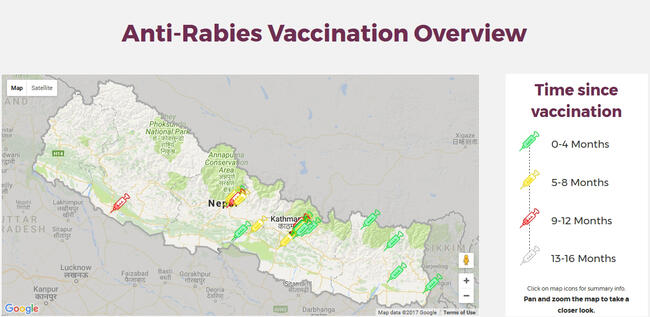Dog data mapping in Nepal
- Community News
- Dog vaccination
A public information website for Nepal (www.dogdata.uk) has just been set up to show where and when anti-rabies vaccinations have taken place by mapping the locations of recently vaccinated dogs. The site was developed by Himalayan Animal Rescue Trust (HART) but involves the collaboration of other animal welfare NGOs as well. It also shows recent censuses of dog populations and will eventually include information on neutering campaigns.
Visitors to the site can initially see an overview of vaccination areas countrywide, and then they can zoom in to their own town and street to see when and by whom their local animals were vaccinated. The syringe symbols denoting each vaccination are green for the first four months, then turn yellow for the next four months, then red for the next four, and then finally into grey outlines for the last four months. After 16 months, the syringes disappear because it is presumed that by then the area will have lost most of its protection and the dogs should be re-vaccinated.
Many of the major animal welfare NGOs in Nepal are already contributing their data, including Animal Nepal, Community Dog Welfare and National Animal Welfare Research Centre, and several others have been invited to join. Data collection is facilitated by the use of an Android mobile phone app, MARVIN, developed by HART. This app records vaccination data and calculates how many animals must be included to ensure at least 70% population coverage. If the app is not used, summary data can be posted to the site and can be shown over the town or village that has been covered to indicate the numbers of animals reached and date of delivery.
Another app acts as a census recorder and helps organisations obtain a good estimate of the dog population, condition and constituent animals in a specified area.
The aims of the site include:
- Informing the Nepali public about whether their local dogs are immunised or not
- Informing the Nepali authorities about vaccination programmes in their areas
- Informing NGOs and other groups where work has taken place so as to avoid overlaps
- Informing researchers with recent information on canine vaccination data
Rabies surveillance in Nepal is challenging, and so it is hoped that the site can play a part in improving rabies surveillance by providing a facility to log the location of rabid animals, both suspected and confirmed. In order to be a useful conduit for citizen science, the site will need to be repeatedly brought to the attention of the public. A press and media campaign will be launched in due course that will attempt to fix Dog Data–as a reliable and simple resource for all–in the public mind.
The vaccination of dogs is only one key component of any national rabies elimination strategy. Disease surveillance, the timely provision of human pre- and post-exposure vaccination and public awareness are also essential. It is hoped that the provision of clear evidence regarding dog vaccinations will enable the responsible authorities in Nepal to better define and develop a national strategy.
The site is very much in its infancy and any feedback and queries are welcomed. Please contact enquiries@dogdata.uk for further information.
Submitted by Barbara Webb, of Himalayan Animal Rescue Trust (HART). The website is publicly accessible at www.dogdata.uk.

